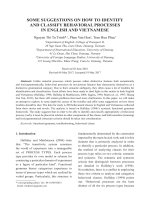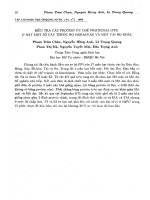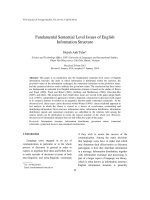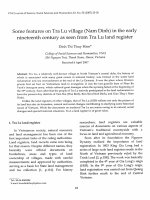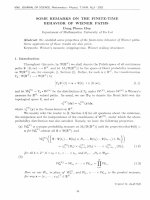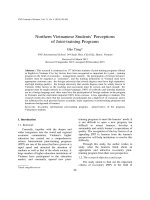DSpace at VNU: Concise report on study of proteinase inhibitors and their utilization in practice (from 1986 - july 2007)
Bạn đang xem bản rút gọn của tài liệu. Xem và tải ngay bản đầy đủ của tài liệu tại đây (1.13 MB, 8 trang )
T ạ p chí Khoa học ĐHQGHN, Khoa học Tự nhiên và Công nghệ 23 (2007) 223-230
Concise report on study of proteinase inhibitors and their
utilization in practice (from 1986 - July 2007)
Pham Thi Tran Chau*
Institute o f Microbiology and Biotechnology , VNƯ, 144Xuan Thuy, Hanoi, Vietnam
Received 12 December 2007
Abstract. Proteinase inhibitors (PIs) are wide]y distributed in plants, microorganisms and
mammalian species; they are known to play pivotal roles in regulating proteinase activities in these
species. Accordingly, PIs are important molecular tools for many research disciplines. Studies of
the coưelation of PI structures and íunctions have lead to understanding of their inhibitory actions
against physiological important proteases. There are potential therapeutic applications for such
studies for diseases rclating to excessive activities of proteases. Our studies on PIs in Viet nam
have been begun sincc 1986, focusing on the following topics:
Quantitative analysis of proteinase inhibitory activity (PIA) in wild type and cultivated plants;
tracing of PIs in the process of seed development and the disưibution of PIs in different parts of
seed; establishment of the procedure for isolation of the selecteđ PIs; the procedure for using PIs
preparations in medical and agricultural practice; characterization of the isolated PIs, study of
their structure; investigation of theừ potential therapeutic and agricultural applications; clinical
trial studies for the selected PIs preparations.
This paper is a brief summary of our 56 works published in the national and intemational
joumals as well as at the symposia and conferences .
Keywords: proteinase inhibitors, Momordica cochinchinensis, anti-inflamation, anti-bacterial
activity, insecticide.
Proteinase inhibitors are quite common in
nature and also present in all life íbrms.The
corresponding inhibitors of most proteases
exist in nature. They are known to play a
pivotal role in regulating proteolytic activity
in living ceỉls. Thereíòre, ửiey are expected to
be an effective tools for treatment of diseases
causeđ by excessive activity o f proteases,
bloking proteolytic process involving an
infecting, inílammation processes. Protease
inhibitors (PIs) have also been used as
insecticide. In Viet nam, our laboratory have
1. Introduction
Proteases are widely íound in plants, and
animals as well as in microorganisms. It is
reported that 2% o f all gene Products are
proteases (Barret et all 1998). They play a
crucial role in the physiology and pathology of
living organisms by conừolling the synthesis,
tumover and function o f proteins.
* ĐT: 84-4-7547638
E-mail:
223
224
P .T .T . C h â u / T ạ p c h í K h o a h ọ c Đ H Q G H N , K h o a học T ự N h iê n v à C ô n g n g h ệ 2 3 (2 0 0 7 ) 2 2 3 -2 3 0
been studying trypsin inhibitors (TIs) since
1986 as a continuance o f our previous work
[1]. The subjects o f our research on PIs include:
Quantitative
analysis
of
proteinase
inhibitory activity (PIA) in wild type and
cultivated plants [2-9]. Tracing o f PIs in the
process o f seed development [10-17], and the
distribution o f PIs in different parts o f seed [4,
18,19].
Establishment o f
isolation o f the PIs
procedure for using
medical and agricultural
the procedure for
[20-26] and o f the
PIs preparations in
practice [21,27-30].
Characterization o f the isolated PIs, study
of theừ structure [23,28,31-35] and their
potential
therapeutic
and
agricultural
applications [36-42].
Clinical trial studies for the selected PIs
preparations [29,43,44].
2. Comprehensive Results (abridged)
2.2. The insecticidal activity o f Mos.
The insecticidal activity experiments have
been carried out in our laboratory and in green
vegetable íìeld and targeted the larvae of
Spodoprera litura (Sl) and Plutelỉa xylosteỉla
(Px), which severely destroy green vegetale
field. The laboratory assays showed that after 2
days o f íeeding the 21*1 instar larvae of Px by
leaves treated with Mos, the insecticidal effect
(calculated according Henderson Tillton)
reached 70-80%. Moreover, Mos was able to
inhibit the growth and the development of SI
and Px 2™1 and 3ri instar larvae, thus reducing
their destruction ability [23]. Besides, Mos
also reduced the portion o f larvae entenng the
pupa, and increased the rate o f anomalous
butterílies by half (16.42% while in control
was 8.56%) [45-47].
Experiments on the íìeld with mustard
greens, cabbages, kohlrabi, caulif!owers
showed that the insecticida] effect agains Px of
Mos reached more than 60% [48].
It has been known that plant proteinase
inhibitors, which play a potent deíensive role
against predators and pathogens, are natural,
deíense-related proteins often present in seeds
and induced in certain plant tissues by
herbivory or wounding. Several plant serine-
As is known, several serine-proteinase
inhibitors promote the insecticidal activity of
the
insect control
proteins
from B.
thuringinensis (Bt) against their target insects.
In fact, the insecticidal effect against Px of a
mixed preparation o f Mos with Bt (each
ingređient 50% o f its using dose, named MM)
was higher
than that o f Mos or Bt
preparation alone. Moreover MM had no
negative effect on the leaves of green
vegetables (The National Research project
proteinase inhibitors exhibit insecticidal as
coded KHCN-02-08B conducted by ửie author)
2.1.
Quantiíaíive analysis trypsin inhibitor
activity (TIA) o f various wide and cultivated
plants
showed
that
Momordica
cochinchinensis seeds (MCo) are the richest
source o f TIs [3].
well as antibacterial activities . These findings
along with our knowledge in the use o f MCo
seeds in traditional medicine prompted us to
search for insecticidal and antimicrobial
properties o f a MCo TIs- rích preparation
named "Momorsetatin " or “Mos
2.3. The antimicrobial activity o f Momoseriatin
preparation [38,43,49]
Mos preparation was partly purified by gel
íiltration chromatography on Sephadex G-75
P .T .T . C h â u / T ạ p c h í K h o a h ọ c Đ H Q G H N , K h o a h ọ c T ự N h iê n v à C ô n g n g h ệ 2 3 (2 0 0 7 ) 2 2 3 -2 3 0
column.The TI ÍTactions were pooled (named
MCoTIs).By using PAGE copolymerized with
substrate, three TIs bands were detected on the
gel. The Rm values o f these TIs bands
corresponded to those o f protein bands
detected by using PAGE Laemmli method.
In connection with the antimicrobial
activity o f McoTIs, 145 microbial samples
including those isolated from soil, from pus of
patient’s bum wound have been tested. The
results obtained have indicated that the
antimicrobial activity o f MCoTIs is unspecific:
it inhibited the growth o f both negative ( G ')
and
positive
(G+)
bacteria,
Candida,
Aspergillus and Streptomyces. A study the
sensitivity o f the microorganisms to MCoTIs
indicated that at low concentration, MCoTIs
only inhibited bacteria but not
fungi nor
sừeptomyces [50]. Further study was carried
out on bacteria isolated from infected wound.
Inhibition o f MCoTIs on bacteria isoỉated
from pus o f patient's infected b u m wound
(Pibwp).
Among bacteria isolated from Pibwp, the
apparition
frequency o f
Staphylococcus
aureus (Sa) and Pseudomonas aeruginosa
(Pseu) were around 39% and 30% respectively
[37]. These bacteria, particularly Pseu strongly
inhibited by MCoTIs. Therefore, extracellular
proteinases o f Pseu (Pseu-PA) were isolated
and subjected for study. The total proteolytic
activity (PA) o f cell-free broth
strongly
decreased in the presence o f MCoTIs [38,43].
The partly puriíied two PA peaks (P1 and P2)
obtained by fìractionation o f Pseu-PA on
Sephadex G-75 column and followed by FPLC
(with Q column) were also strongly inhibited
by MCoTIs. MCoTIs- treated P1 and P2 before
loading on polyacrylamide gel, and after
running electrophoresis, soaking the gel in
buíĩer containing MCoTIs, PA bands o f P1
and P2 were ceascd [38].
225
2.4. The anti-in/Iammatory action o f proteinase
inhibitors (Pls) preparations on experìmental
models.
As is known several PIs have been
effectively used to diminish inílammatory
process such as acute pancreatitis. Thereíore,
besides MCoTIs other PI named AT-04 have
been investigated. AT-04* isolated from
bovine lung inhibiting serine proteinases
including trypsin, chymotrypsin, plasmin were
subjected to study o f theừ eíĩect on
experimental acute and chronic inílammatory
models as well as experimental pancreatitis
[36,40,44]. Both tested PIs preparations
reduced inílammatory processes in both acute
and chronic inílammatory models. In the
experimental acute pancreatitis, a beneficial
effect was
'AT-04 is a preparations produced by us
[21,22,31], a product o f the National
Biotechnology Research prọject coded 52D03-10 and KC-08-04) observed when using
AT-04 in combination wiứi Somatostatin (Vu
Ha, Ph.D thesis, 2001) None toxical eíĩect of
AT-04 and MCoTIs was found on tested
animal.
Thirty eight patients with iníecteđ bum
wound were eíĩectìvely treated by AT-04:
inAammation was reduced, the process of
wound healing was improved, the duration o f
ưeatm ent was shortened and no side effect was
observed (Do L. Tuan, MSc. Thesis, 1999)
All above results have encouraged us to
deeper study on PIs from MCo seeds.
2.5. Characterừation ofTIs from MCo seeds
Three TIs (MCoTI-I, MCoTI-II and
M CoTI-in have been purifíed, characterized
and sequenced [23,28,32]. All o f them contain
three disulfiđe bridges. The M CoTI-in (the
226
P .T .T . C h â u / T ạ p c h í K hoa h ọ c Đ H Q G H N , K h o a h ọ c T ự N h iê n v à C ô n g n g h ệ 23 ( 2 0 0 7 ) 2 2 3 - 2 3 0
minor TI) is the linear polypeptide backbone
composing o f 30 amino acid residues. MCoTIn and -m consisting o f 34 amino acid
residues with N to c termini ligation (head to
tail ligation) [32] named a “cyclotides”. They
have been recorgnized to be the íữst known
macrocyclic inhibitors o f Cucurbitaceae TI
family [32]. Further study indicated that
MCoTI-II íormed a new family o f Cyclic
Knottin [33,34]. The MCoTI-I was being
synthesized by chemical method [51]. The
gene coding for MCoTI-n was also
synthesized, cloned and expressed in E.coli
[52]. A recombinant Ti-plasmid carring
MCoTI-II was also been constructed [53].
Besides, we also cloned and expressed in
E. coli of the gene coding for other TI from
pumpkin (Cucurbitaceae maxima) seeds
named CMTI-V (TI
speciíĩcally inhibited
factor Xlla) [54-56]. In the presence o f the
recombinant CMTI-V,
activated
partial
thromboplastin time (APTT) increased.
Kalanchoe pinata leaves have been used
for treatment o f bum and pustule. From our
premilinary study, their leaf extract exhibiteđ
high TIA and ChlA. The liophylized leaf juice
possess TIA and ChlA o f about 180 - 474
m iu /g and 635- 3060 m iu /g respectively.
After ữactionation on Sephadex G-25 column,
two peaks were obtained. The first, major peak
(D l) inhibited both trypsin, chymotrypsin and
the growth o f
Pseudomonas aeruginosa
isolated from patient’s infected bum wound
pus. Further study indicated that DI also
reduced the proteolytic activity o f the p.
aeruginosa. Moreover, the inhibitory specific
activity
(m iu/m g
protein)
against
p.
aeruginosa was about 2 - 8 fold higher than
that against trypsin and chymotrypsin. Thus, it
was suggested that PIs in the leaf juice may
play an important role for the antibacterial
activity o f the Kalanchoe leaves [9].
At present, we focus our work on screening
PIs potented therapeutic uses from medicinal
plants and further study the selected subjects.
2.6. Trypsin inhibitors from medicinal plants .
Up to-day, we have assayed the trypsin
inhibitory activity (TIA),
chymotrypsin
inhibitory activity (ChlA) and proteoỉytic
activity (PA) o f
200 samples from 129
medicinal plants Corning from 55 plant
families. Among the investigated ones, 70
plants have been used for treatment o f skin
diseases. O f the crude extracts, 41.8 % were
found to possess PA, and 58.2% exhibited
inhibitory activity against (TIA), 29.5 %
against chymotrypsin (ChlA). However, there
were only 4% o f the leaf extracts found to
possess both TIA and ChlA higher than
lOOmlU/gam o f leaves. It is also been noticed
that in the same extract, ChlA was higher than
TIA (Pham thi Tran Chau'Hoang Thu Ha et al.,
unpublisfed data).
Reíerences
[1] Pham Thi Tran Chau, Trypsin inhibitors of
white bush (Cucurbita pcpo var. pattissonina)
fruits and sceds, Wrocỉaw University Publisher.
(1987) 110 pages (English)
[2] Pham Tran Thi Chau, P.T. Ha, N.Q. Vinh,
Screening the proteolytic activity and the
antiproteolytic activity from Algae strains.
Jo um al o f Science o f the Hanoi University ,
Vol. 4, No.42 (1993) 50 (in Vietnamcse).
[3] Pham Thi Tran Chau, V.T. Hien, P.T. Ha,
N.H.M. Quyen, N.T. Mai, Preliminary data of
trypsin inhibitors (TIs) from squash seeds of
Viet nam, I ơ h FAOB (Federation o f AKìan and
Oceanian Biochemists) Symposium on protein.
Research. Taipei ,7-10/12/1993. Abstracts PI1I-21.
[4] N.H.M. Quyen, Pham Thi Tran Chau,
Distribution of trypsin inhibitors in loofah
P .T .T . C h â u Ị T ạ p c h í K hoa học Đ H Q G H N , K hoa h ọ c T ự N h iê n v à C ô n g n g h ệ 2 3 (2 0 0 7 ) 223-230
(Luffa cyỉindrica Roem) and pumpkin
(Cucurbita pepo L.). Proceedings o f the Ilth
FAOBMB
Symposium
15-18/11/1994.
Biopolymers and Bioproducts: Structure,
Functions
and
Applications
p.399-405.
[5]
[6 ]
[7]
[8 ]
Samakkhisaĩi
(dokya)
Public Company
Limited, 1995.
Pham thi Tran Chau, N. H. Anh, L.T. Quang,
P.T. Ha, N. T.Mai, D.T. Anh, Investigation of
proteinase protein inhibitors (PPIs) from seeds
of ccrtain plants belonging to Moraceae family
and other ones, VNU. Journal o f Science, Nat.,
S c i T XV, N03 (1999) 1 (in Vietnamese).
Phan T. Ha, D. X. Nghiem, Pham Thi Tran
Chau, Study on the trypsin, chymotrypsin
inhibitors from medicinal pỉants and their
antibacterial activity, Issues o f basic research
in Life sciences, Science and Technique
Publishing house, Ha noi, (2003) 1086-1090 (in
Vietnamese).
Hoang T. Ha, Pham Thi Tran Chau, Some
biochemical components and biological activity
of thc placente-frce fruit juice of Momordica
chanrantia L., Journaỉ o f Biology 28, 1 (2006)
75 (in Vietnamese).
Hoang Thu Ha, Pham Thi Tran Chau, Study on
trypsin inhibitor (TI) and chymotrypsin
inhibitor(KI) from seeds of blue dragon
(Hylocereus undatus Britt.& Rose), VNU
Joum al o f Science, Natural Sciences and
Technology T XXIII, N° 1 (2007) 26 (in
Vietnamese).
[9] Dao T. Thuy, H.T. Ha, Pham Thi Tran Chau,
Study on proteinase inhibitors and antibacterial
activity of coirama (Kalanchoe pinnata) leaves
juice, J. o f Bioỉogy Vol. 29, N°2 (2007) 84 (in
Vietnamcsc).
[10] Phan T. Nghia, Pham Tran Chau, Changes in
Trypsin inhibitory activity (TIA) and
proteolytic activity of developing seeds and
fruits of Momordica charantia L., Joumal of
Biology
Vol.9, No.3 (1987) 12 (in
Vietnamese).
[11] Phan T. Nghia, Pham Tran Chau, Trypsin
inhibitors in đeveloping seeds of Momordica
charantia L., Proceedỉng o f the National Center
fo r Sciertíựìc Research o f Vietnam. Vol 2
(1990) 129-135.
227
[12] Nguyen T. Mai, P.N. Thanh, Pham Thi Tran
Chau, Changes in trypsin inhibitors and some
other
biochemical
components
during
dev«lopment of looíah {Lujfa cyỉindrica Roem)
seeds, Joum al o f Bioỉogy Vol. XIV, No.3
(1992) 28 (in Vietnamese).
[13] Pham Tran Chau, Biosynthesis of trypsin
inhibitors (TIs) during development of
Cucurbitaceae seeds, 7 th FAOBMB Congress
24-29/9/1995. Sydney, Ausíralia, Abstracts
POS-2-143.
[14] N.H.M. Quyen, N.Quang Huy, Pham Tran
Chau, A comparison of trypsin inhibitors (TIs)
from 30 days old seeds and dormant seeds of
looíah, Journaỉ o f Biology Vol.l 8 , No.4 (1996)
26 (in Vietnamese).
[15] N.H.M. Quyen, N.H. Nga, Pham Thi Tran
Chau, Changes in Trypsin inhibitors of
developing seeđs of Luffa cylindrica roem
(LC), luffa acutangula roxb (LA) and coccinia
India (CI), VNU Journal o f Science, Natural
Sciences and Technology T.XIII, No.3 (1997)
20 (in Vietnamese).
[16] L.T. Quang, N.A. Tuan, Pham Thi Tran Chau,
T.D. Long, Study on protein, TIA and ChlA of
some soybean during germination, Joum al o f
Bioiogy Vol. 19, No.3 (1997) 46 (in Vietnamese).
[17] N.Q. ưyen, L.T. Quang, T.H. Thai, P.T. Ha,
Pham Thi Tran
Chau, L.N. Dung, Jean
Francois, Laurent Chiche, Study on the change
of trypsin inhibitors (TI) in the seeds of
Momordica cochinchinensis during their
íormation and development, Joưm aỉ o f Bioỉogy
Vol. 24 (1) (2002) 35 (in Vietnamese).
[18] N.H.M. Quyen, Pham Tran Chau, The
distribution of trypsin inhibitors in Looíah
(Lụffa cyỉindrica Ro em.) plants, Joum al o f
Biology Vol. 15, No.4 (1993) 70 (in Vietnamese).
[19] Pham Thi Tran Chau, L.N. Dung, L.Chiche,
J.F. Hemandez, A. Heitz, J. Gagnon, J.p.
Anderieu, T.H. Thai, N.T. Mai, P.T. Ha, N.Q.
ưyen, L.T. Quang, T.Q. Tan, H.T. Viet, T.D.
Pha, L.T. Cu, Trypsin inhibitors (Its) from
Momorđica cochinchinensis seeds. 16ỉó
FAOBMB Symposium, From genes to proteins:
Frơntiers in Biochemistry and Moỉecuỉar
Bioỉogy, Taipci 20-22/9/2002. Program Book,
(2002) p.83. OP22.
228
P.T.T. C h â u Ị T ạ p c h í K h o a h ọ c Đ H Q G H N , K h o a h ọ c T ự N h iê n v à C ô n g n g h ệ 23 (2 0 0 7 ) 223-230
[20] Phan T. Nghia, Pham Tran Chau, Puriĩication
of a TTiajor trypsin inhibitor from Momordica
charantia resting seeds and its somc properties,
Joum aỉ o f Science, ơniversity o f Hanoi , No.4
(1987) 44 (in Vietnamese).
[21] Pham Thi Tran Chau, P.T. Ha, Study on protein
inhibitors of proteinases and the usage of
proteinases in practice, Bulletin o f Scỉentific
acíivity
of
UniversitiesBiology
and
Agricuỉture, (1991) 95-102 (in Vietnamese).
[22] Pham Thi Tran Chau, N.T. Mai, P.T. Ha,
Puriíĩcation, characterization of antilysin from
bovine Lung and preliminary study regarđing
its practical uses, Joum aỉ o f Bioỉogy Vol.15,
No.4 (1993) 8 (in Vietnamese).
[23] N.T.Mai, Pham Thi Tran Chau, A comparison
of trypsin inhibitors (TIs) from domant seeds of
Momordica cochinchinensis bcfore (Go) and
after (Gx) heat treatment. VNU Joum al o f
Science, Natural Sciences and Technology Vol.
XII, No.3 (1996) 33 (in Vietnamese).
[24] N.Q. Vinh, Pham Thi Tran Chau, N.T. Mai,
P.T.Ha, Estimation of Momosertatin remainder
on ỉeavcs after using Momosertatin as
bioinsecticidc, Joum aỉ o f Sciences and
technology (VN)y Vol. XXXVI, No. 6 B (1998)
25 (in Vietnamese).
[25] Nguyen Q. ưyen, D.Q. Hung, H.T. Ha, D.T.
Thuy, Pham Thi Tran Chau, Isolation,
puriíĩcation and characterization of protein
proteinase inhibitor from the seeđs of
Nephelium lappaceum L., Journal o f Genetics ,
Special ĩssue: Biotechnoỉogy (2001) 1 (in
Vietnamese).
[26] Le T. Quang, N. p. Nam, P.T. Ha, Pham Thi
Tran Chau, Puriíĩcation and some properties of
two protein protcinase inhibitors from the seeds
of Sophora ịaponìca L.f., Joum aỉ o f Bìology
Voi.25, N°3 (2003) l (in Vietnamese).
[27] Pham Thi Tran Chau, P.T. Ha, N.T. Mai, N.c.
Van, N.L. Dung, Investigation of enzyme,
trypsin inhibitors for improving quality of
nutritious flour feeding infants, Joum al o f
Science o f the Hanoi University, No.3 (1991)
39 (in Vietnamese).
[28] N.T. Mai, Pham Tran Chau, Iníluence of
temperature and ultra violet radiation on the
activity of certain proteinase protein inhibitors
(PPIs). Proceedings o f the I líh FAOBMB
Symposium 15-18/1 ỉ /1994. Biopoỉymers and
Bioproducts:
Structure,
functions
and
Application, pp 405-410.
[29] N.v. Nguyen, Pham Thi Tran Chau, V. Ha,
H.v. Luong, Study on the using of AT-04
preparation for ừeatment of experimental acute
pancreatitis, Joum aĩ o f Applied Medicine
No.350 (1998) 243-250 (m Vietnamese).
[30] Pham Tran Chau, Vu Ha, M.K. Linh, N.p.
Thao, N.T. Bich Huyen, The changes of
Momosertatin (Mo) in the digestion system of
wistar rats. I ơ k Congress o f the Federation o f
Asian and Oceanic Biochemisís and Molecular
Bioỉogits . December 7-11. 2003, Bangalore,
[31]
[32]
[33]
[34]
India. p 25.
N.H. Phuc, T.T. Thi, T.T. Hao, N.L. Trang,
D.N. Lien, Pham Thi Tran Chau, Immunization
to produce antibody 0 f antilizin, Joum al o f
Bioỉogy Vol.15, No.4 (1993) 79 (in Vietnamese).
Jean-Francosis Hemandez, Jean Gagnon,
Laurent Chiche, Tuyet Mai Nguyen, JeanPierre Anđrieu, Annie Heitz, Thai Trinh Hong,
T. Tran Chau Pham, Dung Le Nguyen, Squash
tripsin
inhibitors
from
Momordica
cochinchinensis
contain
an
atypical
macrocyclic structure, Biochem ừtry , Vol. 39
(2000) 5722-5730.
Annie Heitz, Jean-Francois Hemandcz, Jcan
Gagnon, Thai Trinh Hong, T-Tran Chau Pham,
Tuyet Mai Nguyen, Du Le- Nguyen and
Laurent chiche, Solution structure of thc squash
trypsin inhibitor MCoTI-II. A new íamily of
Cyclic Knottin, Biochemistry 40 (2001) 7973-7983.
A.Heitz J.F.Hemandez, J. Gagnon, T.T.Hong,
Chau T.T.Pham, Tuyet M. Nguyen, Dung L.N
and L.Chiche, Solution Structure of the Macro
Cyclic Squash Trypsin inhibitor MCoTI-II, the
íìrst member of a New íamily of Cyclic
Knottins. Peptides: The wave o f the Future.
M ichal Lebl and Richard A.Hocyỉen (Editors)
American Peptide Society, (2001) 387-388.
[35] Laurent Chiche, A.Heitz, J-C Gelly, J.Gracy,
Pham T.Tran Chau, P.T.Ha, J-F Hemandez and
Dung Le-Nguyen, Squash inhibitor: From
structural motií to macrocyclic Knottins.
Current Protein and Peptide Science. Vol. 5.
(2004)341-349.
[36] N.v. Nguyen, L. Huynh, V. Ha, Pham Tran
Chau, P.T. Ha, L.T. Quang, Testing the acute
and chronic anti-inflammation action of AT-04
P .T .T . C h â u / T ạ p c h í K hoa h ọ c Đ H Q G H N , K h o a h ọ c T ự N h iê n v à C ô n g n g h ệ 2 3 (2 0 0 7 ) 223-230
(a product of KC-08-04 rcscarch project) on
experimcntal whitc rats, Bulletin o f Scientific
activity o f Universities, Biology , Agricuỉture
and Medicine (1996) 64 (in Vietnamese).
[37] N.D. Bang, D.L. Tuan, Pham Thi Tran Chau,
Antibactarial effect of AT-04 versus silver
sulfadiazine on partial-thickness bum wound.
Journaỉ o/B ioỉogy Vol. 21, No. 1B (1999) 168.
[38] P.T. Ha, Pham Thi Tran Chau, Effect of
Momosertatin on thc extracellular proteinases
of Pseudomonas isolatcd from bum wound pus.
Joum al o f Biology Vol.22, No.3 (2000) 31-37.
[39] Pham Thi Tran Chau, Protein proteinase
inhibitors from Momordica cochinchinensis
seeds. National Conference on Life Sciences
8-9/10/2000. ỉssues o f Basis research in Life
Sciences (VN). Proceedings, pp. 197-201. and
in J5,h FAOBMB Symposium Beiỳing China,
Program and Abstracts PB-37 , 2000, p.134.
[40] Nguyen V. Nguyen, Vu Ha, L. Nam, D.
L.Tuan, Pham Thi Tran Chau, p. T. Ha,
ỉnvestigatc thc anti-inf!ammatory action of
proteincous
protcinasc
inhibitors
(PIs)
preparations. Issucs of basic rcsearch in life
sciences , with dircction in Medicine and
Pharmacology. Hà nội, October 28, 2004.
Proteinasc inhibitor (PPI) and bum inílamation.
I2th FAOBM Congress Tokushima, Japan, July
29-3 , 1997, Abstracts S-3-19.
[44] N.v. Nguyen, V. Ha, H.v. Luong, Pham Thi
Tran Chau, Testing the anti-inílammation effect
of AT-04 on expcrimental wistar rat. VNU
Joum al o f Science, Nat. Sci., Vol XVI, N°1
(2000) 30-33 (in Vietnamese).
[45] Trinh H. Thai, Pham Thi Tran Chau,
Proteolytic and antiproteolytic activities of
Hclioửiis armigera during thc metamorphosis
process from pupa to adult, Joum aỉ o f Bioỉogy
Vol. XVII, No.3 (1995) 28.
[46] Pham Thi Tran Chau, Mai N. Toan, Tran Q.
Toan, 1997, Effect of Momosertatin on the
growth and mortality of inscct pests, Pluteỉla
xylostella (PX) and Spodoptera litura (SL).
I7th International Congress o f Biochemistry
and Molecular Bioỉogy / ì 997 Annual Meeting
o f the American Society o f Biochemistry and
[47]
Proceedings o f the 2004*h National Conference
on Life Sciences, pp. 287-290.
[41] Dung Lc Nguyen, A.Heitz, L.Chiche, JF.Hemandez, T.H.Phan, Tran-Chau Pham,
Microprotcins from Cucurbitaceae vvith
potcntial thcrapcutic applications: molecular
design of HETI and MCoTI, Proceeding o f the
[48]
International Seminar o f Asian Netvvork o f
Research on Antidiabetic Plants (ANRAP),
January 16-18, Kolkata, India, 2005. pp 81-87;
Mukkeijec & Dubnath, eds; Tata McGraw-Hill
Publishing Company Limited, New Dehli.
[42] Tran Chau Pham, Ha T. Phan, T. Q. Tran, V.T.
Hoang, H. Vu, N.v. Nguyen, J.F. Hemandez,
[49]
A. Hcitz, D.L. Nguyen, L. Chiche, Diverse
bioactivity of Momosertatin (Mos), seeds and
its trypsin inhibitors (TIs), 2 ơ h IƯBMB
International Congress o f Biochem, And Moì.
B iol and ì í h FAOBMB Congress. June 18-23 ,
2006, Kyoto, Japan. Abstracts 5P-C-239, p.832.
[43] Pham Thi Tran Chau, N.v. Nguyen, L.N, N.D.
Bang, P.T. Ha, N.T. Mai, L.tT Quang, N.H.M.
Quyen, D.L Tuan, Proteinase, Protein
229
[50]
Molecular Biology. August 24-29; San
Francisco, Caliĩomia Programm Number 2130.
Dung Le Nguycn, Annie Heitz , Laurent
Chiche, Jean-Francois Hcmandez, t. H. Phan
and Tran Chau Pham, Antimicrobial and
insecticiđal eíĩects
of crude
extract
Momosertatin
(Mos)
íìom
Momordica
cochincnsis seeds.
Peptide
Revolution:
Genomics, Proteomics and Therapeutics. Eds:
Michael Chorev and Tomi K.Sawyer, American
Peptỉde Society, 2003 .
Pham Thi Tran Chau, T.Q. Tan, P.T. Ha, H.T.
Viet, M.N. Toan, N.D. Toan, T.H. Thai,
P.T.Hanh, Insecticidal effect of Momosertatin
preparation isolated
from
Momordica
cochinchinensis seeds on vegetable larvae.
VNU Joum al o f Science, Nat. Sci., Vol XV,
N°3 (2000) 1 (in Vietnamese).
Tran Chau Pham, M.T. Hang, V.T. Hao, N.H.
Ha, N.L. Dung, Effect of Momosertatin on the
growth of microorganisms, 8 th. FẢOBMB
Congress November,
22-27/1998.
Kuala
Lumpur, Malaysia, Abstracts C26. 1998.
Mai T. Hang, p.p. Cong, V.T. Hao, N.T. Dat,
Study on the effect of PPI on the growth of
some
bacteria
causing
bum
wound
inílammation, Bulletin o f Hanoi Pedagogical
college N°4, (2000) 59 (in Vietnamese).
230
P .T .T . C h â u / T ạ p c h í K h o a h ọ c Đ H Q G H N , K h o a h ọ c T ự N h iê n v à C ô n g n g h ệ 23 ( 2 0 0 7 ) 223-230
[51] Lc Nguyen, L.G. Barry, J. Tam, A. Heitz, L.
Chiche, J.F. Hemandez, T.T.C. Pham, The
Chemical synthesis of MCoTI-I by solid phase.
27th European Peptide Symposium, Sorrento
(Itaỉy) August 31-september 6, 2002 poster A 162.
[52] Pham Thi Tran Chau, M.K. Reddy, D.T. Thuy,
H.T. Ha, L.N. Dung, Laurent Chiche, Synthesis,
Cloning and expression in Escherichia Coli of
a gene cođing for MCoTI-II. ư h FAOBMB
Symposium/2** IUBMB Speciaỉ Afeeỉing/7*h AIM BN ConỊerence: Genomics and Health in the
2 ỉ tk. Century. Bangkok, Thailand. Program and
Abstracts. OP-C9, VNU J o u m a l o f Science,
Nat., Sci. á Tech., T.XXI, N01 (2004) 1 (English).
[53] Le T. Thu Hien, D.T. Thu Ha, P.T. Ha, N.D.
Ton, N.v. Hai, Pham Thi Tran Chau,
Construction of a recombinant Ti-plasmid
caiTÌng trypsin inhibitor (MCoTI-II) gcnc from
Momordỉca cochinchinensis , Journal o f Bioíech
Vol.2, N°3, (2004) 334.
[54] Vo.T.T. Lan, Pham Thi Tran Chau, Cloning of
the genes encoding trypsin inhibitor (Tl-IV)
from , Cucurbitaceae. Jo um al Genetics and
Applications.
Speciaỉ
issue:
Biotechnology
(2001) 17 (in Vietnamese).
[55] Dao T. Thuy, N.Q. Uyen, N.T. Bich Hau, V.T.
Thuong Lan, Pham Thi Tran Chau, Cloning and
expresion in E. coli of the gene coding for
pumpkin (Cucurbita maxima) tripsin inhibitor,
CMTI-V, VNU Joum al o f Science, Nat., Sci. <&
Tech., T.xx, N°3 (2004) 1 (in Vietnamese).
[56] Dang X. Nghiem, P.T. Ha, N.p. Nam, Pham
Thi Tran Chau, Puriíĩcation of a recombinant
trypsin inhibitor CMTI-V. ưh FAOBMB
Symposium/Ĩ"ứ IUBMB Speciaỉ M eetingƯ h AIM B N Conference: Genomics and Health in the
21th Century Bangkok, Thailand. Program and
Abstracts. 2004. PO-6.23.
Tóm lược kêt quả nghiên cứu và ứng dụng các chât ức chê
Proteinase (từ 1986-7/2007)
Phạm Thị Trân Châu
Viện Vi Sinh vật và Công nghệ Sinh học, ĐHQGHN, 144 Xuân Thủy, Hà Nội, Việt Nam
Các chất ức chế proteinase (PI) khá phổ biến trong tự nhiên, chúng có vai trò quan trọng ữong điều
hòa hoạt động của proteinase của cơ thể sống. Do đó các PI có thể là công cụ quan trọng trong nhiều
lĩnh vực nghiên cứu khác nhau. Nghiên cứu liên quan giữa cấu trúc và chức năng cùa các PI có thể
làm sang tỏ tác dụng ức chế của chúng đối với các protease tham gia vào các quá trình sinh lý quan
trọng. Các nghiên cứu này có ý nghĩa đối với việc nghiên cứu sử dụng các Pl để điều trị các bệnh có
liên quan với sự tăng hoạt độ của potease quá mức bình thường. Chúng tôi bắt đầu nghiên cứu các PI
từ năm 1986, chủ yếu tập trung vào một số vấn đề sau: định lượng các PI của các mẫu cây mọc dại và
cây trồng; theo dõi sự biến đổi các PI trong quá trình phát triển của hạt và sự phân bố cùa các PI ở các
phần khác nhau của hạt; xây dựng quy trinh tách các PI, quy trình ứng dụng các chế phẩm PI trong y dược và nông nghiệp; nghiên cửu thử nghiệm các chế phẩm PI đã tuyển chọn.
Bài này tóm tắt các kết quả nghiên cứu đã công bố ừong 56 công trình đăng trong các Tạp chí
khoa học trong và ngoài nước, và các báo cáo ờ các Hội nghị quốc gia và quốc tế. Hịện nay, chúng tôi
đang tiếp tục nghiên cứu các PI của các cầy thuốc Việt Nam để tuyển chọn các PI có tiềm năng ứng
dụng thực tế và tìm hiểu thêm về liên quan của chúng với tác dụng dược lý của cây.


